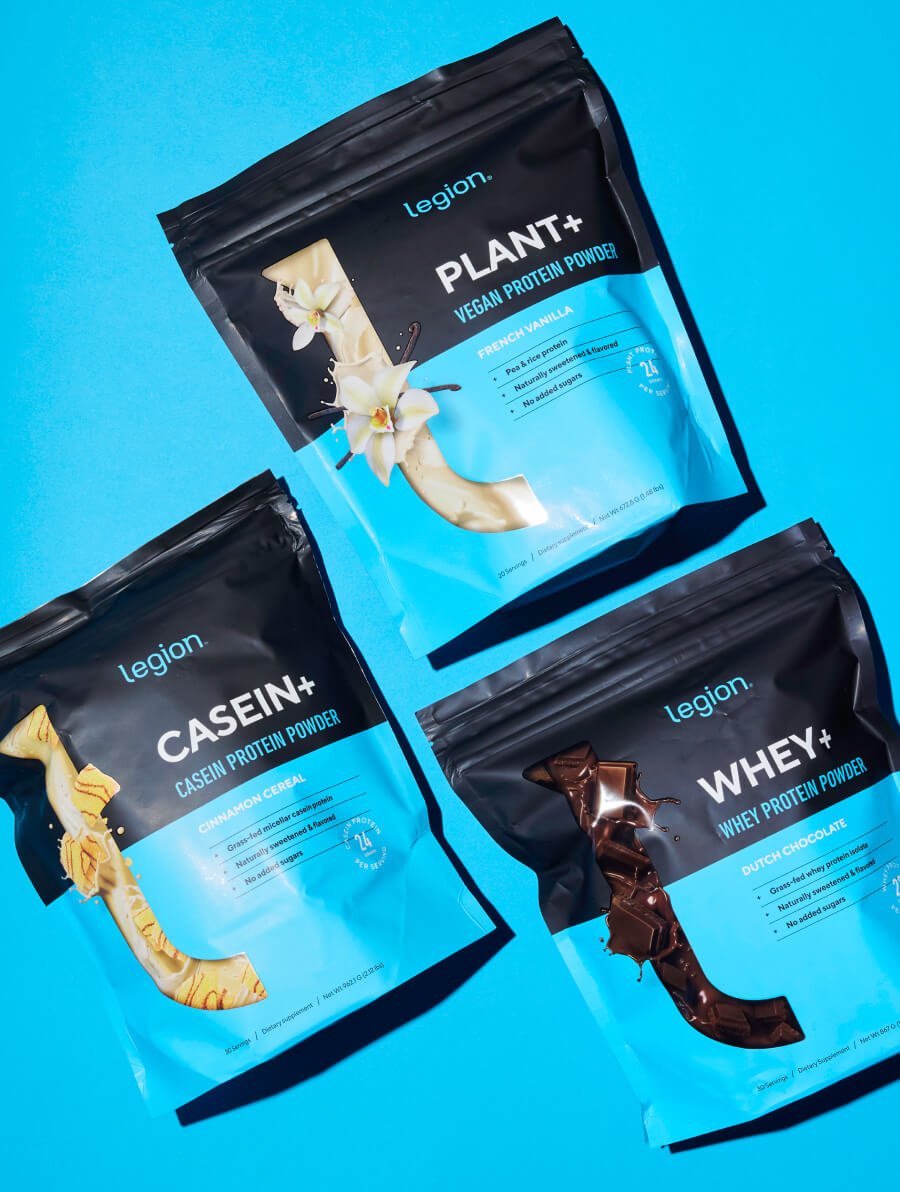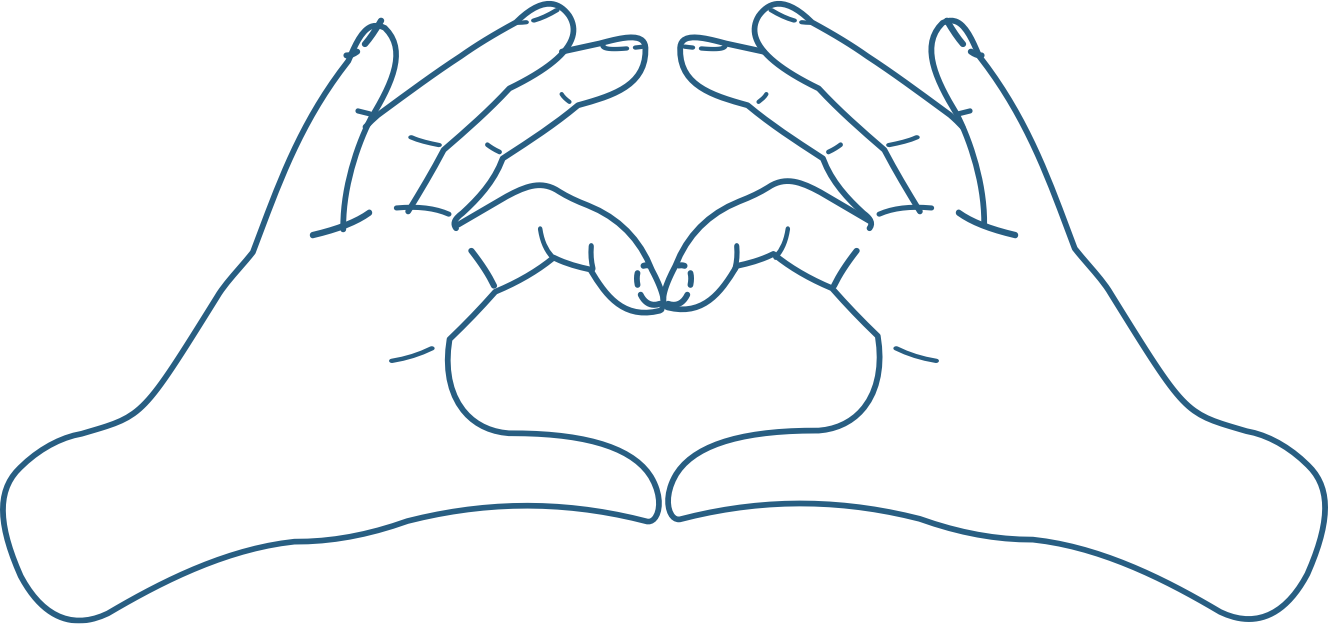Most people think a hypertrophy training program means high reps, light weights, and chasing a pump until your limbs go numb.
It doesn’t.
In reality, the best hypertrophy workout programs look a lot like good strength programs—heavy compound weightlifting, regular progression, and just enough volume to grow, but not so much that you burn out.
This article shows you exactly how to stimulate hypertrophy (build muscle) efficiently.
You’ll learn how hypertrophy works, what actually drives muscle growth, and how to follow a hypertrophy plan that builds serious size and strength—without wasting time or spinning your wheels.
Key Takeaways
- Muscle hypertrophy is the scientific term for an increase in muscle cell size.
- To stimulate hypertrophy, you need to create high levels of mechanical tension in your muscle fibers, and the best way to do this is by lifting heavy weights.
- The best hypertrophy programs focus on progressive overload and compound exercises, and they balance intensity and volume in a way that maximizes growth without burning you out.
- To get the most out of a hypertrophy workout program, eat enough calories and protein, train close to failure, prioritize sleep, and deload every 8-to-10 weeks.
- Following a hypertrophy training plan helps you build muscle, makes managing your weight easier, and dramatically improves your overall health.
Table of Contents
+
What Is Hypertrophy?
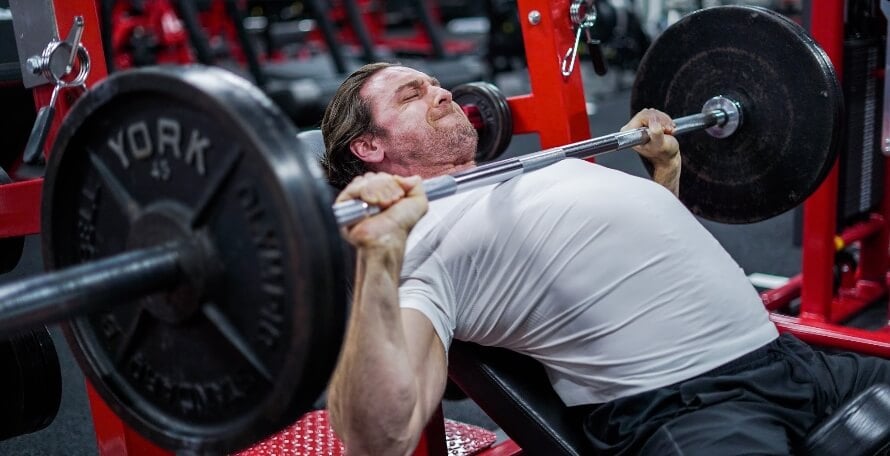
Muscle hypertrophy is the scientific term for an increase in muscle cell size.
Hyper means “over” or “more,” and trophy means “growth,” so muscle hypertrophy literally means the growth of muscle cells.
Technically, you can achieve muscle hypertrophy by increasing any of the three main components of muscle tissue—water, glycogen, or protein—though weightlifters are usually most interested in increasing the amount of protein in muscle (also known as myofibrillar hypertrophy).
READ MORE: Good Question: What Is Muscle Hypertrophy?
How to Stimulate Hypertrophy
To simulate hypertrophy (build muscle) you first have to create a lot of mechanical tension in your muscle fibers. The best way to achieve this is lifting heavy weights.
High levels of mechanical tension activate proteins in muscle cells called mechanosensors, which stimulate the body to ramp up mammalian target of rapamycin, or mTOR, an enzyme that boosts protein synthesis (the creation of new muscle fibers).
But it’s not just about lifting heavy weights. You also need to produce enough volume of tension over time. For instance, squatting as much weight as possible for a single rep creates tons of tension, but without enough reps or sets, the growth signal remains weak.
In other words, there’s a minimum volume of tension required to stimulate muscle growth.
You also need to give your body enough rest and “raw materials”—mainly protein and calories—to actually build new muscle. Without them, you blunt the muscle-building effects of training and increase protein breakdown, which cancels out some of your gains.
Now let’s break down how to put all this together into an effective hypertrophy training program.
Hypertrophy Training Program Fundamentals
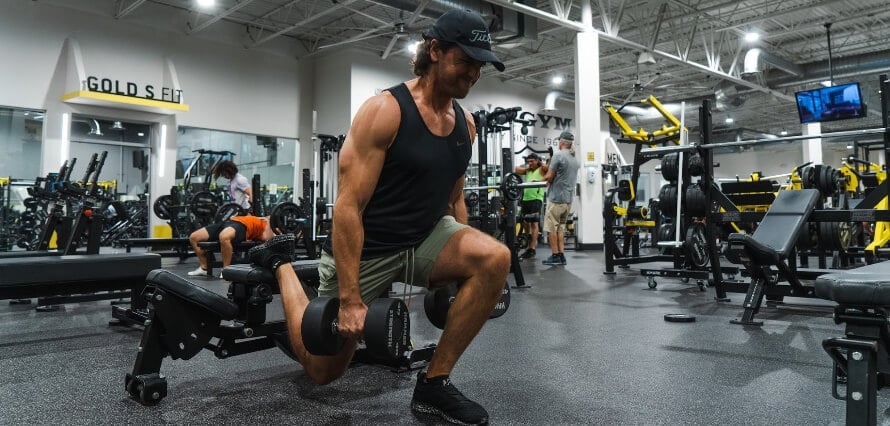
To build muscle efficiently, your hypertrophy plan needs to follow a few key principles. Here’s what matters most.
Progressive Overload
To maximize the hypertrophic effects of weightlifting, you must strive to add weight or reps to every exercise in every workout. This is known as progressive overload, and it’s the single biggest driver of muscle growth.
To progressively overload your muscles effectively, follow this rule: once you hit the top of your rep range for one set, add weight.
For instance, if your hypertrophy training program calls for 4-to-6 reps of the deadlift and you get 6 reps for a set, add 10 pounds to your next set.
If you manage 3 or fewer reps with the new weight, reduce the weight by 5 pounds to ensure you stay in the 4-to-6 rep range.
Follow this pattern of trying to add reps or weight to every exercise in every workout.
READ MORE: Double Progression Guide: How to Use Double Progression to Gain Muscle and Strength
Training Volume
To maximize hypertrophy, most research shows you need to train each major muscle group with 10-to-20 weekly sets. Doing more than 20 might produce better results for some, but growth rapidly diminishes beyond this point, so the extra work is rarely worth the effort.
Training with very high volumes has practical downsides, too: it’s time-consuming, and unless your recovery (sleep, diet, etc.) is flawless, it’s hard to sustain.
That’s why all good hypertrophy programs (like the one below) include 10-to-20 weekly sets for each major muscle group.
READ MORE: How Many Sets Should You Do for Muscle Hypertrophy?
Training Intensity
To make your hypertrophy training program as effective as possible, take most of your sets to within 1-to-3 reps of failure—the point where you can’t perform another rep with proper form.
To gauge whether you’re reaching this point, ask yourself at the end of each set: “If I had to, how many more reps could I have done with good form?”
If the answer is more than two, increase the weight or reps on your next set to make it more challenging.
READ MORE: Does Training to Failure Help You Build More Muscle? What Science Says
Exercise Selection
Research shows that if you want to maximize muscle hypertrophy, nothing beats compound weightlifting.
A compound exercise is any type of exercise that trains several major muscle groups at the same time, like the squat, deadlift, and bench and overhead press.
Isolation exercises—those that involve just one joint and major muscle group at a time—still have a place in a hypertrophy training program, but if building muscle is your main goal, you should put most of your energy into compound exercises.
Rep Range
Despite what some “experts” say, you don’t need to do 20+ reps per set to build muscle.
While it’s possible to build muscle using high rep ranges, research shows that they’re only effective if you take each set to failure.
There are two problems with this training style:
- Doing high-rep sets is extremely unpleasant (sets take longer, feel harder, and cause more fatigue than lower-rep sets).
- Training to failure regularly can increase your risk of injury.
By increasing the weight and doing fewer reps per set, however, you can produce a powerful muscle- and strength-building stimulus without busting a gut or training to failure.
The Best Hypertrophy Workout Program
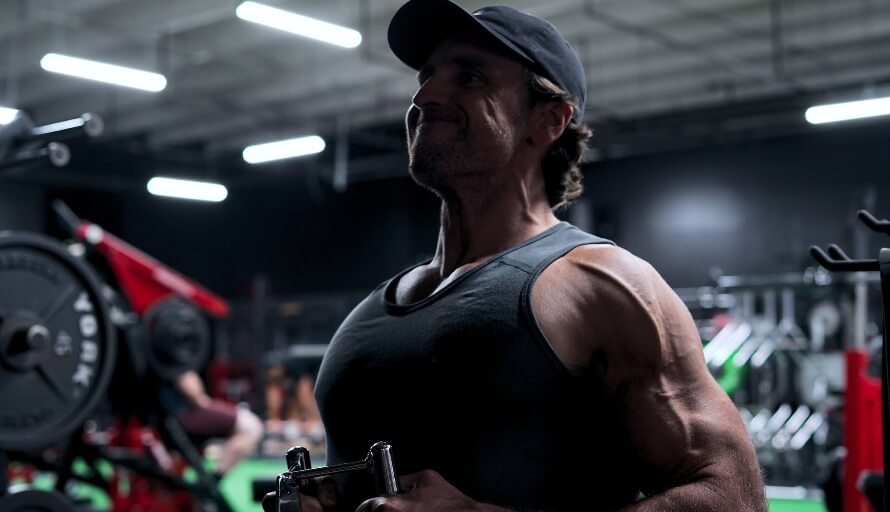
For decades, natural bodybuilders have used this 5-day hypertrophy workout program to build mass.
It works so well because it includes all the best muscle-building exercises and the perfect balance of volume and intensity to spur rapid growth without wearing you to a frazzle.
If the 5-day hypertrophy workout program doesn’t fit your schedule, you can shorten it to a 4-day routine by skipping Day 5. And if you’d prefer to do a 3-day routine, skip Day 3 and Day 5.
Day 1: Push
- Barbell Bench Press: 3 sets | 4-to-6 reps | 3-to-5 min rest
- Incline Barbell Bench Press: 3 sets | 4-to-6 reps | 3-to-5 min rest
- Dumbbell Bench Press: 3 sets | 6-to-8 reps | 2-to-3 min rest
- Triceps Pushdown: 3 sets | 6-to-8 reps | 2-to-3 min rest
Day 2: Pull
- Barbell Deadlift: 3 sets | 4-to-6 reps | 3-to-5 min rest
- One-Arm Dumbbell Row: 3 sets | 4-to-6 reps | 3-to-5 min rest
- Lat Pulldown: 3 sets | 6-to-8 reps | 2-to-3 min rest
- Seated Cable Row: 3 sets | 6-to-8 reps | 2-to-3 min rest
Day 3: Upper A
- Seated Dumbbell Press: 3 sets | 4-to-6 reps | 3-to-5 min rest
- Alternating Dumbbell Curl: 3 sets | 6-to-8 reps | 2-to-3 min rest
- Dumbbell Side Lateral Raise: 3 sets | 6-to-8 reps | 2-to-3 min rest
- Dumbbell Rear Lateral Raise: 3 sets | 6-to-8 reps | 2-to-3 min rest
Day 4: Lower
- Barbell Back Squat: 3 sets | 4-to-6 reps | 3-to-5 min rest
- Leg Press: 3 sets | 4-to-6 reps | 3-to-5 min rest
- Lying Leg Curl: 3 sets | 6-to-8 reps | 2-to-3 min rest
- Seated Calf Raise: 3 sets | 6-to-8 reps | 2-to-3 min rest
Day 5: Upper B
- Close-Grip Bench Press: 3 sets | 4-to-6 reps | 3-to-5 min rest
- Weighted Pull-up: 3 sets | 4-to-6 reps | 3-to-5 min rest
- Dumbbell Overhead Triceps Extension: 3 sets | 6-to-8 reps | 2-to-3 min rest
- Barbell Curl: 3 sets | 6-to-8 reps | 2-to-3 min rest
5 Tips to Optimize Your Hypertrophy Training Program Results
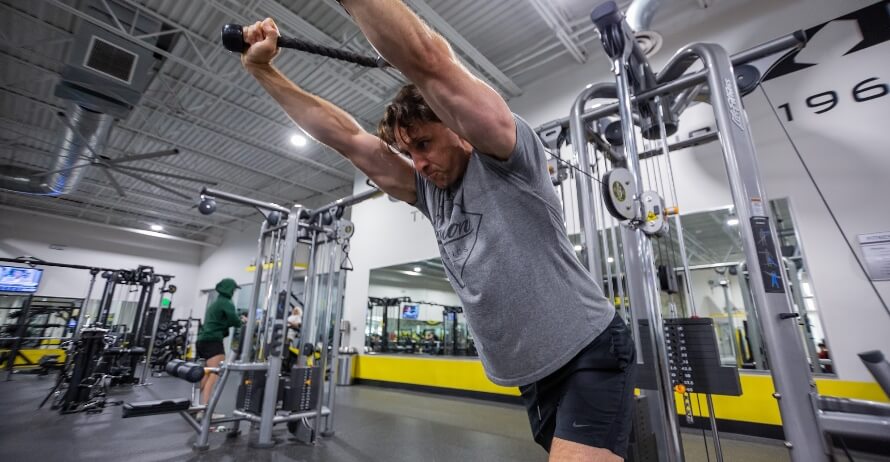
1. Eat enough calories and protein.
To maximize muscle and strength gain while following this hypertrophy training program, maintain a daily calorie surplus of around 110% of your total daily energy expenditure (TDEE). In other words, eat around 10% more calories than your body burns daily.
You also need to eat enough protein to allow your muscles to recover, repair, and grow effectively. Aim to eat 0.8-to-1 gram of protein per pound of body weight per day.
For personalized advice about exactly how many calories to eat, how much of each macronutrient, and which foods you should consume to reach your fitness goals, take the Legion Diet Quiz.
2. Warm up correctly.
Warming up at the beginning of each workout is crucial for optimizing performance and preventing injury.
Here’s the science–based protocol I recommend:
- Estimate the weight you’ll use for your first hard set of your first exercise.
- Do 6 reps with about 50% of that weight and rest for 1 minute.
- Do 4 reps with about 70% of that weight and rest for 1 minute.
After this, you’re ready to tackle your hard sets for your first exercise and the rest of your hypertrophy workout.
3. Deload every 8-to-10 weeks.
A deload is a short period—usually a week—where you intentionally reduce your training volume or intensity to lower fatigue, ease joint and tendon strain, and reduce mental stress.
While people debate the best deload strategy, I recommend cutting volume rather than intensity. Research shows this approach is more effective for reducing fatigue (the main goal) and helps maintain strength, making it easier to resume hard training afterward.
How long you take between deloads is up to you—some people recover faster than others—but a good rule of thumb is every 8-to-10 weeks of hard training.
Here’s a simple way to do it:
- Follow the same workouts as the previous week
- Do 2 hard sets per exercise instead of 3
- Use your normal working weights
- For exercises you usually do in the 4-to-6 rep range, do 3 reps per set
- For exercises in the 6-to-8 rep range, do 4 reps per set
4. Get enough sleep.
To get the most out of your hypertrophy plan, you need to sleep well.
Getting 7-to-9 hours per night improves mood, energy, workout performance, and recovery. It also supports muscle growth by boosting anabolic hormones and reducing muscle breakdown.
On top of that, it helps you stay on track with your diet by lowering cravings and improving self-control, making it less likely you’ll overeat.
5. Take the right supplements.
These supplements can help optimize your results while following a hypertrophy workout program:
- Protein powder: Protein powder, such as whey or casein, provides your body with the nutrients needed to build muscle tissue and recover from workouts.
- Creatine: Creatine boosts muscle and strength gain, improves anaerobic endurance, and reduces muscle damage and soreness from your workouts.
- Pre-workout: A high-quality pre-workout enhances energy, mood, and focus, increases strength and endurance, and reduces fatigue.
(If you’d like even more specific advice about which supplements you should take to reach your health and fitness goals, take the Legion Supplement Finder Quiz, and in less than a minute, you’ll know exactly what supplements are right for you. Click here to check it out.)
The Benefits of Following a Hypertrophy Training Program
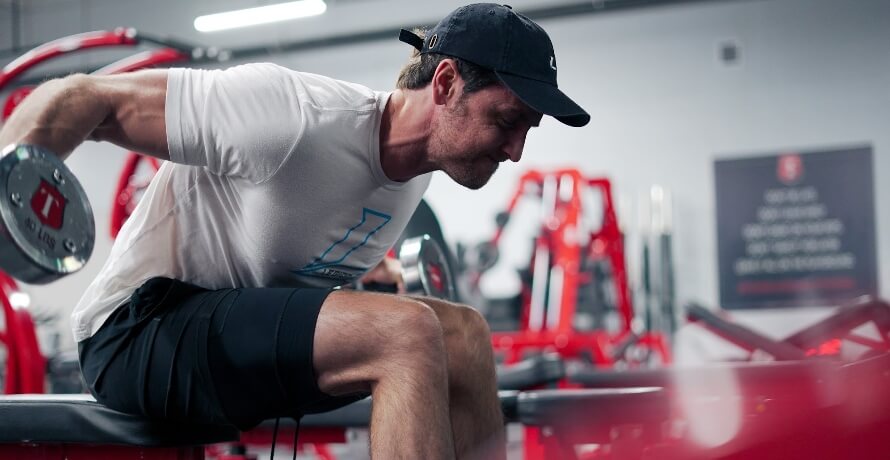
You now know what hypertrophy is, how to stimulate it, and how to train for it effectively.
But why follow a hypertrophy training program plan in the first place?
Here are the main benefits.
Muscle Growth
The most obvious benefit: you’ll build muscle. And that makes performing everyday tasks easier, protects you against injury, boosts your athletic performance, extends your life expectancy, and helps you maintain good metabolic health.
And yes, more muscle may also make you look better.
Fat Loss
Lifting weights boosts your resting metabolic rate, helping you burn more calories even at rest. That’s because muscle tissue is more “metabolically active” than fat.
It also triggers your muscles to release special particles called extracellular vesicles into your blood. As they leave your muscles, they carry strands of genetic material called miR-1 to fat cells. When miR-1 is in muscle tissue, it hinders muscle growth, but once it’s deposited in fat cells, it hastens fat burning.
In other words, lifting weights causes subtle shifts in the expression of certain genes that support long-term fat loss at the molecular level.
Optimal Health
Lifting weights improves just about every marker of health, including . . .
- Body composition
- Blood pressure
- Blood glucose level
- Insulin sensitivity
- Mobility and physical function
- Blood lipid profile
- Bone mineral density
- Bone health
- Cognition
- Immune function
It also lowers your risk of major diseases—like cancer, cardiovascular disease, type 2 diabetes, osteoporosis, and nonalcoholic fatty liver disease—and enhances mental health by boosting self-esteem, mood, and independence as you age.
FAQ #1: What’s the best hypertrophy routine for beginners?
The hypertrophy training program in this article works great for beginners.
If you’re brand new to lifting, start by training three days per week—it’s enough to build muscle effectively while giving you plenty of time to recover. To do this, just skip workouts 3 and 5.
That said, if you’re feeling up to it and want the fastest results, follow the full program as written.
FAQ #2: How do you pronounce hypertrophy?
It’s pronounced hai-PUR-truh-fee, with the stress on the second syllable (PUR).
FAQ #3: Are drop sets good for hypertrophy?
Research shows that drop sets are a perfectly viable way to build muscle—but they’re not better than traditional training.
They’re also often more grueling. Repeatedly pushing to failure is more uncomfortable and mentally draining than traditional sets, which can make your workouts feel less enjoyable. And since they don’t produce better results, most people prefer to stick with regular sets.
That said, if you’re short on time, drop sets can be a useful tool. They let you pack more work into less time—as long as you’re willing to suffer a little.
FAQ #4: Should I go to failure on every set for hypertrophy?
No—you don’t need to go to failure on every set to build muscle, and doing so may actually backfire.
Research shows that training to failure isn’t better than stopping a few reps short. It can also increase fatigue, hurt your performance in later sets, and make workouts less enjoyable.
Instead, finish most sets 1-to-3 reps shy of failure, especially on compound exercises. If you want to push to failure occasionally, save it for the last set of an isolation exercise.
FAQ #5: What rep range is best for hypertrophy?
You can gain muscle doing anywhere from ~3-to-30+ reps per set, so the “best” rep ranges for hypertrophy are largely the ones you enjoy the most.
I typically recommend training in lower rep ranges—like 4-to-6 or 6-to-8—for a few practical reasons:
- When you train with heavier weights, you can generally progress (increase the weights you lift) more regularly, which is motivating. It also helps you gain strength more effectively, which becomes vital for gaining muscle as you near your genetic potential for growth.
- Lifting heavy weights feels less fatiguing, which can make workouts more enjoyable. For example, most people would prefer three 6-rep sets of squats over three 20-rep sets of squats, especially if you had to move on to other taxing exercises like the leg press and lunge.
- Sets of more reps take longer to complete and tax your cardiovascular system more than sets of fewer reps, forcing you to take longer rest periods to catch your breath. Together, this adds significant time to your workouts.
Scientific References +
- Schoenfeld, B. J. (2010). The mechanisms of muscle hypertrophy and their application to resistance training. In Journal of Strength and Conditioning Research (Vol. 24, Issue 10, pp. 2857–2872). J Strength Cond Res. https://doi.org/10.1519/JSC.0b013e3181e840f3
- Goldberg, A. L., et al. “Mechanism of Work-Induced Hypertrophy of Skeletal Muscle.” Medicine and Science in Sports, vol. 7, no. 3, 1975, pp. 185–198, pubmed.ncbi.nlm.nih.gov/128681/.
- Graham, Zachary A., et al. “Focal Adhesion Kinase and Its Role in Skeletal Muscle.” Journal of Muscle Research and Cell Motility, vol. 36, no. 4-5, 4 July 2015, pp. 305–315, https://doi.org/10.1007/s10974-015-9415-3. Accessed 14 Nov. 2020.
- Yoon, Mee-Sup. “MTOR as a Key Regulator in Maintaining Skeletal Muscle Mass.” Frontiers in Physiology, vol. 8, 17 Oct. 2017, https://doi.org/10.3389/fphys.2017.00788. Accessed 8 May 2020.
- MATTOCKS, KEVIN T., et al. “Practicing the Test Produces Strength Equivalent to Higher Volume Training.” Medicine & Science in Sports & Exercise, vol. 49, no. 9, Sept. 2017, pp. 1945–1954, https://doi.org/10.1249/mss.0000000000001300. Accessed 27 Nov. 2020.
- “View of the Resistance Training Dose-Response: Meta-Regressions Exploring the Effects of Weekly Volume and Frequency on Muscle Hypertrophy and Strength Gain.” Sportrxiv.org, 2024, sportrxiv.org/index.php/server/preprint/view/460/967.
- Gentil, P., Soares, S., & Bottaro, M. (2015). Single vs. Multi-joint resistance exercises: Effects on muscle strength and hypertrophy. Asian Journal of Sports Medicine, 6(2), 1–5. https://doi.org/10.5812/asjsm.24057
- Schoenfeld, Brad J., et al. “Strength and Hypertrophy Adaptations between Low- vs. High-Load Resistance Training.” Journal of Strength and Conditioning Research, vol. 31, no. 12, Dec. 2017, pp. 3508–3523, https://doi.org/10.1519/jsc.0000000000002200.
- Ribeiro, Alex S., et al. “Acute Effects of Different Training Loads on Affective Responses in Resistance-Trained Men.” International Journal of Sports Medicine, vol. 40, no. 13, 9 Sept. 2019, pp. 850–855, https://doi.org/10.1055/a-0997-6680. Accessed 22 Mar. 2020.
- Schoenfeld, Brad J., et al. “Loading Recommendations for Muscle Strength, Hypertrophy, and Local Endurance: A Re-Examination of the Repetition Continuum.” Sports, vol. 9, no. 2, 22 Feb. 2021, p. 32, pmc.ncbi.nlm.nih.gov/articles/PMC7927075/, https://doi.org/10.3390/sports9020032.
- Helms, E. R., Aragon, A. A., & Fitschen, P. J. (2014). Evidence-based recommendations for natural bodybuilding contest preparation: Nutrition and supplementation. In Journal of the International Society of Sports Nutrition (Vol. 11, Issue 1, p. 20). BioMed Central Ltd. https://doi.org/10.1186/1550-2783-11-20
- Ribeiro, Bruno, et al. “The Role of Specific Warm-up during Bench Press and Squat Exercises: A Novel Approach.” International Journal of Environmental Research and Public Health, vol. 17, no. 18, 22 Sept. 2020, p. 6882, https://doi.org/10.3390/ijerph17186882.
- BICKEL, C. SCOTT, et al. “Exercise Dosing to Retain Resistance Training Adaptations in Young and Older Adults.” Medicine & Science in Sports & Exercise, vol. 43, no. 7, July 2011, pp. 1177–1187, https://doi.org/10.1249/mss.0b013e318207c15d.
- Izquierdo, Mikel, et al. “Detraining and Tapering Effects on Hormonal Responses and Strength Performance.” The Journal of Strength and Conditioning Research, vol. 21, no. 3, 2007, p. 768, https://doi.org/10.1519/r-21136.1. Accessed 15 Apr. 2020.
- Bosquet, Laurent, et al. “Effects of Tapering on Performance.” Medicine & Science in Sports & Exercise, vol. 39, no. 8, Aug. 2007, pp. 1358–1365, pubmed.ncbi.nlm.nih.gov/17762369/, https://doi.org/10.1249/mss.0b013e31806010e0.
- Mujika, I. “The Influence of Training Characteristics and Tapering on the Adaptation in Highly Trained Individuals: A Review.” International Journal of Sports Medicine, vol. 19, no. 07, Oct. 1998, pp. 439–446, https://doi.org/10.1055/s-2007-971942.
- Hamlin, Michael J., et al. “The Effect of Sleep Quality and Quantity on Athlete’s Health and Perceived Training Quality.” Frontiers in Sports and Active Living, vol. 3, no. 3, 10 Sept. 2021, https://doi.org/10.3389/fspor.2021.705650.
- Kirschen, Gregory W., et al. “The Impact of Sleep Duration on Performance among Competitive Athletes.” Clinical Journal of Sport Medicine, vol. 30, no. 5, June 2018, p. 1, https://doi.org/10.1097/jsm.0000000000000622.
- Nedeltcheva, A. V., Kilkus, J. M., Imperial, J., Schoeller, D. A., & Penev, P. D. (2010). Insufficient sleep undermines dietary efforts to reduce adiposity. Annals of Internal Medicine, 153(7), 435–441. https://doi.org/10.7326/0003-4819-153-7-201010050-00006
- Yang, Chia-Lun, et al. “Increased Hunger, Food Cravings, Food Reward, and Portion Size Selection after Sleep Curtailment in Women without Obesity.” Nutrients, vol. 11, no. 3, 19 Mar. 2019, www.ncbi.nlm.nih.gov/pmc/articles/PMC6470707/, https://doi.org/10.3390/nu11030663.
- Alahmary, Sarah A., et al. “Relationship between Added Sugar Intake and Sleep Quality among University Students: A Cross-Sectional Study.” American Journal of Lifestyle Medicine, vol. 16, no. 1, 23 Aug. 2019, p. 155982761987047, https://doi.org/10.1177/1559827619870476.
- Tucker, Robin M, et al. “The Influence of Sleep on Human Taste Function and Perception: A Systematic Review.” Journal of Sleep Research, 18 June 2024, https://doi.org/10.1111/jsr.14257.
- Stokes, T., Hector, A. J., Morton, R. W., McGlory, C., & Phillips, S. M. (2018). Recent perspectives regarding the role of dietary protein for the promotion of muscle hypertrophy with resistance exercise training. In Nutrients (Vol. 10, Issue 2). MDPI AG. https://doi.org/10.3390/nu10020180
- Jd, Branch. “Effect of Creatine Supplementation on Body Composition and Performance: A Meta-Analysis.” International Journal of Sport Nutrition and Exercise Metabolism, 1 June 2003, pubmed.ncbi.nlm.nih.gov/12945830/.
- Eckerson, Joan M., et al. “Effect of Creatine Phosphate Supplementation on Anaerobic Working Capacity and Body Weight after Two and Six Days of Loading in Men and Women.” The Journal of Strength and Conditioning Research, vol. 19, no. 4, 2005, p. 756, https://doi.org/10.1519/r-16924.1.
- Bassit, Reinaldo Abunasser, et al. “Effect of Short-Term Creatine Supplementation on Markers of Skeletal Muscle Damage after Strenuous Contractile Activity.” European Journal of Applied Physiology, vol. 108, no. 5, 3 Dec. 2009, pp. 945–955, https://doi.org/10.1007/s00421-009-1305-1.
- THOMAS, MICHAEL H, and STEVE P BURNS. “Increasing Lean Mass and Strength: A Comparison of High Frequency Strength Training to Lower Frequency Strength Training.” International Journal of Exercise Science, vol. 9, no. 2, Apr. 2016, p. 159, pmc.ncbi.nlm.nih.gov/articles/PMC4836564/.
- Jadczak, Agathe D., et al. “Effectiveness of Exercise Interventions on Physical Function in Community-Dwelling Frail Older People.” JBI Database of Systematic Reviews and Implementation Reports, vol. 16, no. 3, Mar. 2018, pp. 752–775, https://doi.org/10.11124/jbisrir-2017-003551. Accessed 21 June 2019.
- Levinger, I., et al. “The Effect of Resistance Training on Functional Capacity and Quality of Life in Individuals with High and Low Numbers of Metabolic Risk Factors.” Diabetes Care, vol. 30, no. 9, 11 June 2007, pp. 2205–2210, https://doi.org/10.2337/dc07-0841.
- Lauersen, Jeppe Bo, et al. “The Effectiveness of Exercise Interventions to Prevent Sports Injuries: A Systematic Review and Meta-Analysis of Randomised Controlled Trials.” British Journal of Sports Medicine, vol. 48, no. 11, 7 Oct. 2014, pp. 871–877, bjsm.bmj.com/content/48/11/871, https://doi.org/10.1136/bjsports-2013-092538.
- Suchomel, Timothy J., et al. “The Importance of Muscular Strength: Training Considerations.” Sports Medicine, vol. 48, no. 4, 25 Jan. 2018, pp. 765–785, pubmed.ncbi.nlm.nih.gov/29372481/, https://doi.org/10.1007/s40279-018-0862-z.
- Rodríguez-Rosell, David, et al. “Physiological and Methodological Aspects of Rate of Force Development Assessment in Human Skeletal Muscle.” Clinical Physiology and Functional Imaging, vol. 38, no. 5, 20 Dec. 2017, pp. 743–762, https://doi.org/10.1111/cpf.12495.
- Seitz, Laurent B., et al. “Increases in Lower-Body Strength Transfer Positively to Sprint Performance: A Systematic Review with Meta-Analysis.” Sports Medicine, vol. 44, no. 12, 25 July 2014, pp. 1693–1702.
- “American College of Sports Medicine Position Stand. Exercise and Physical Activity for Older Adults.” Medicine and Science in Sports and Exercise, vol. 30, no. 6, 1 June 1998, pp. 992–1008, pubmed.ncbi.nlm.nih.gov/9624662/. Accessed 6 Mar. 2021.
- Kim, Gyuri, and Jae Hyeon Kim. “Impact of Skeletal Muscle Mass on Metabolic Health.” Endocrinology and Metabolism, vol. 35, no. 1, 2020, p. 1, https://doi.org/10.3803/enm.2020.35.1.1.
- MacKenzie-Shalders, Kristen, et al. “The Effect of Exercise Interventions on Resting Metabolic Rate: A Systematic Review and Meta-Analysis.” Journal of Sports Sciences, vol. 38, no. 14, 12 May 2020, pp. 1635–1649, https://doi.org/10.1080/02640414.2020.1754716.
- Farinatti, Paulo TV, and Antonio G Castinheiras Neto. “The Effect of Between-Set Rest Intervals on the Oxygen Uptake during and after Resistance Exercise Sessions Performed with Large- and Small-Muscle Mass.” Journal of Strength and Conditioning Research, vol. 25, no. 11, Nov. 2011, pp. 3181–3190, https://doi.org/10.1519/jsc.0b013e318212e415.
- Fatouros, Ioannis G., et al. “Intensity of Resistance Exercise Determines Adipokine and Resting Energy Expenditure Responses in Overweight Elderly Individuals.” Diabetes Care, vol. 32, no. 12, 3 Sept. 2009, pp. 2161–2167, https://doi.org/10.2337/dc08-1994. Accessed 1 Nov. 2022.
- Vechetti, Ivan J., et al. “The Role of Extracellular Vesicles in Skeletal Muscle and Systematic Adaptation to Exercise.” The Journal of Physiology, vol. 599, no. 3, 18 Feb. 2020, pp. 845–861, https://doi.org/10.1113/jp278929. Accessed 19 May 2022.
- Chen, Jian-Fu, et al. “The Role of MicroRNA-1 and MicroRNA-133 in Skeletal Muscle Proliferation and Differentiation.” Nature Genetics, vol. 38, no. 2, 1 Feb. 2006, pp. 228–233, www.ncbi.nlm.nih.gov/pubmed/16380711, https://doi.org/10.1038/ng1725.
- Lopez, Pedro, et al. “Resistance Training Effectiveness on Body Composition and Body Weight Outcomes in Individuals with Overweight and Obesity across the Lifespan: A Systematic Review and Meta‐Analysis.” Obesity Reviews, vol. 23, no. 5, 21 Feb. 2022, https://doi.org/10.1111/obr.13428. Accessed 8 May 2022.
- de Sousa, Evitom Corrêa, et al. “Resistance Training Alone Reduces Systolic and Diastolic Blood Pressure in Prehypertensive and Hypertensive Individuals: Meta-Analysis.” Hypertension Research, vol. 40, no. 11, 3 Aug. 2017, pp. 927–931, https://doi.org/10.1038/hr.2017.69.
- Bweir, Salameh, et al. “Resistance Exercise Training Lowers HbA1c More than Aerobic Training in Adults with Type 2 Diabetes.” Diabetology & Metabolic Syndrome, vol. 1, no. 1, 2009, p. 27, https://doi.org/10.1186/1758-5996-1-27. Accessed 1 Aug. 2019.
- Paquin, Jasmine, et al. “Exercising for Insulin Sensitivity - Is There a Mechanistic Relationship with Quantitative Changes in Skeletal Muscle Mass?” Frontiers in Physiology, vol. 12, 2021, p. 656909, pubmed.ncbi.nlm.nih.gov/34054574/, https://doi.org/10.3389/fphys.2021.656909.
- Ajayi-Vincent, O, and M Adesina. “EFFECTS of RESISTANCE TRAINING on the BLOOD LIPID VARIABLES of YOUNG ADULTS.” Of Human Kinetics and Health Education, vol. 9, no. 12, 2013, pp. 1857–7881, core.ac.uk/download/pdf/236412208.pdf. Accessed 13 Apr. 2025.
- Villareal, Dennis T., et al. “Aerobic or Resistance Exercise, or Both, in Dieting Obese Older Adults.” New England Journal of Medicine, vol. 376, no. 20, 18 May 2017, pp. 1943–1955, www.ncbi.nlm.nih.gov/pmc/articles/PMC5552187/pdf/nihms889796.pdf, https://doi.org/10.1056/nejmoa1616338.
- Hong, A Ram, and Sang Wan Kim. “Effects of Resistance Exercise on Bone Health.” Endocrinology and Metabolism, vol. 33, no. 4, 2018, p. 435, pmc.ncbi.nlm.nih.gov/articles/PMC6279907/, https://doi.org/10.3803/enm.2018.33.4.435.
- Boyle, Patricia A., et al. “Association of Muscle Strength with the Risk of Alzheimer Disease and the Rate of Cognitive Decline in Community-Dwelling Older Persons.” Archives of Neurology, vol. 66, no. 11, 1 Nov. 2009, https://doi.org/10.1001/archneurol.2009.240. Accessed 22 Nov. 2019.
- Hagstrom, Amanda D., et al. “The Effect of Resistance Training on Markers of Immune Function and Inflammation in Previously Sedentary Women Recovering from Breast Cancer: A Randomized Controlled Trial.” Breast Cancer Research and Treatment, vol. 155, no. 3, 28 Jan. 2016, pp. 471–482, https://doi.org/10.1007/s10549-016-3688-0. Accessed 26 Sept. 2020.
- Garatachea, Nuria, et al. “Elite Athletes Live Longer than the General Population: A Meta-Analysis.” Mayo Clinic Proceedings, vol. 89, no. 9, Sept. 2014, pp. 1195–1200, www.sciencedirect.com/science/article/abs/pii/S0025619614005199, https://doi.org/10.1016/j.mayocp.2014.06.004.
- Stamatakis, Emmanuel, et al. “Does Strength-Promoting Exercise Confer Unique Health Benefits? A Pooled Analysis of Data on 11 Population Cohorts with All-Cause, Cancer, and Cardiovascular Mortality Endpoints.” American Journal of Epidemiology, vol. 187, no. 5, 31 Oct. 2017, pp. 1102–1112, https://doi.org/10.1093/aje/kwx345. Accessed 28 Jan. 2020.
- Lee, JungHoon, et al. “Resistance Training for Glycemic Control, Muscular Strength, and Lean Body Mass in Old Type 2 Diabetic Patients: A Meta-Analysis.” Diabetes Therapy, vol. 8, no. 3, 5 Apr. 2017, pp. 459–473, link.springer.com/article/10.1007/s13300-017-0258-3, https://doi.org/10.1007/s13300-017-0258-3.
- Hashida, Ryuki, et al. “Aerobic vs. Resistance Exercise in Non-Alcoholic Fatty Liver Disease: A Systematic Review.” Journal of Hepatology, vol. 66, no. 1, Jan. 2017, pp. 142–152, https://doi.org/10.1016/j.jhep.2016.08.023. Accessed 27 Aug. 2020.
- Ciccolo, Joseph T, et al. “Muscular Strength Is Associated with Self-Esteem in College Men but Not Women.” Journal of Health Psychology, vol. 21, no. 12, 11 July 2016, pp. 3072–3078, https://doi.org/10.1177/1359105315592051. Accessed 5 Dec. 2020.
- Gordon, Brett R., et al. “Association of Efficacy of Resistance Exercise Training with Depressive Symptoms.” JAMA Psychiatry, vol. 75, no. 6, 1 June 2018, p. 566, jamanetwork.com/journals/jamapsychiatry/article-abstract/2680311, https://doi.org/10.1001/jamapsychiatry.2018.0572.
- Khodadad Kashi, Sholeh, et al. “A Systematic Review and Meta-Analysis of Resistance Training on Quality of Life, Depression, Muscle Strength, and Functional Exercise Capacity in Older Adults Aged 60 Years or More.” Biological Research for Nursing, vol. 25, no. 1, 13 Aug. 2022, p. 109980042211209, https://doi.org/10.1177/10998004221120945.
- Coleman, Max, et al. “Muscular Adaptations in Drop Set vs. Traditional Training: A Meta-Analysis.” International Journal of Strength and Conditioning, vol. 2, no. 1, 28 Nov. 2022, https://doi.org/10.47206/ijsc.v2i1.135.
- Refalo, Martin C., et al. “Influence of Resistance Training Proximity-To-Failure on Skeletal Muscle Hypertrophy: A Systematic Review with Meta-Analysis.” Sports Medicine, vol. 53, no. 3, 5 Nov. 2022, https://doi.org/10.1007/s40279-022-01784-y.
- Schoenfeld, Brad J., et al. “Effects of Different Volume-Equated Resistance Training Loading Strategies on Muscular Adaptations in Well-Trained Men.” Journal of Strength and Conditioning Research, vol. 28, no. 10, Oct. 2014, pp. 2909–2918, https://doi.org/10.1519/jsc.0000000000000480.
- Kubo, Keitaro, et al. “Effects of 4, 8, and 12 Repetition Maximum Resistance Training Protocols on Muscle Volume and Strength.” Journal of Strength and Conditioning Research, vol. 35, no. 4, Apr. 2020, p. 1, https://doi.org/10.1519/jsc.0000000000003575.
- Baz-Valle, Eneko, et al. “Total Number of Sets as a Training Volume Quantification Method for Muscle Hypertrophy.” Journal of Strength and Conditioning Research, vol. Publish Ahead of Print, no. 3, 30 July 2018, https://doi.org/10.1519/jsc.0000000000002776.




